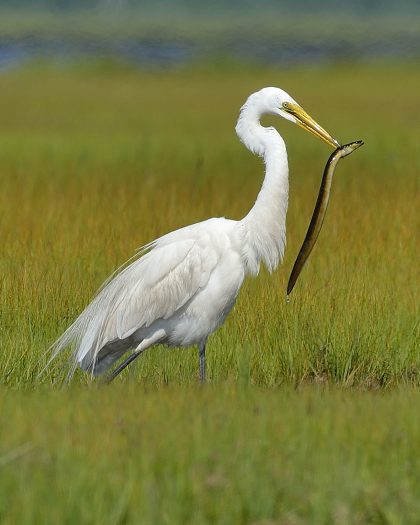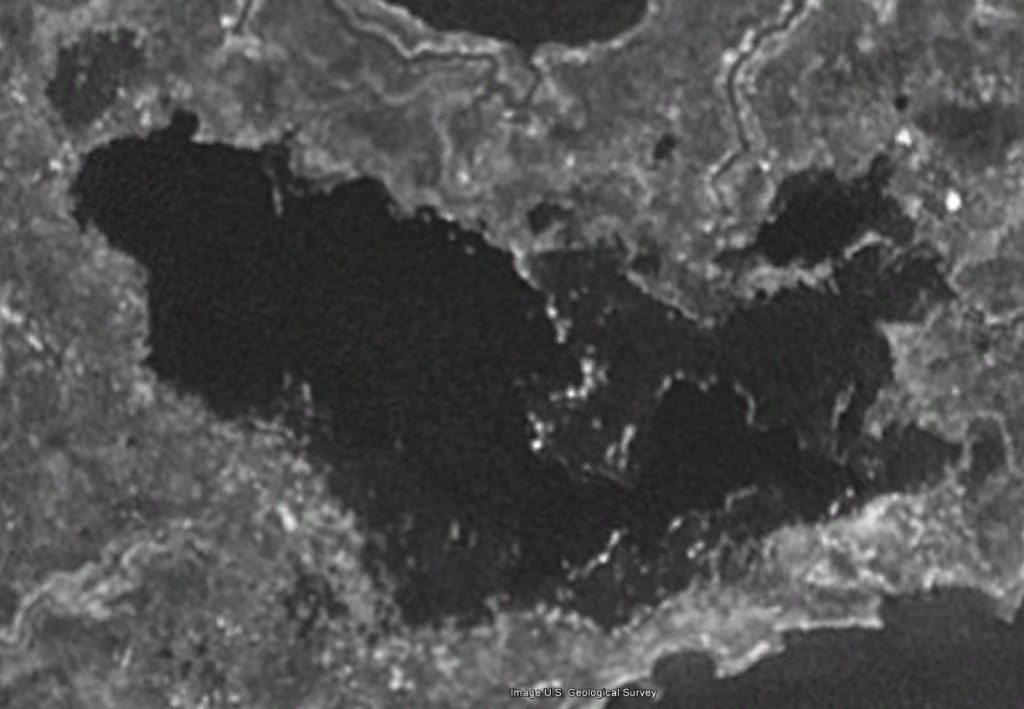
In South Jersey Atlantic coast salt marshes, pools are characteristic features, along with meandering tidal creeks of varying sizes and broad sounds that separate marsh islands.
Salt marsh pools are full of aquatic life: small fish, eels, crabs, snails and aquatic vegetation like wigeongrass.
All this life attracts ducks, herons, egrets, shorebirds, terns and gull to feed and roost on the pools. It also attracts raccoons and otters, whose tracks I see all around pools.
Ditched marshes often don’t have pools.
Ditching, with its regularly spaced grid of narrow channels, intersects and drains them. Ditching makes for a duller marsh.
This was the extent of my understanding of salt marsh pools for a long time: unditched marshes are a good thing because they have pools and natural tidal creeks, and pools are particularly great wildlife habitat.
But as I’ve accumulated experience on South Jersey’s marshes I noticed something else going on: pool breaching.

The classic pool is non-tidal. It holds water at all times, perched in the middle of the marsh amidst winding tidal creeks.
But as I’ve visited the same places over the years, I’ve noticed pools enlarge until their sides intersect with a creek. When this happens the pool becomes tidal. At low tide the pool drains to a mud flat and at high tide it brims with water.
I’ve lost some favorite duck hunting spots to pool breaching. It is much less convenient to hunt on a tidal pond because one must always fret over the coming and going tide.
I asked myself, “Is this a sign of unprecedented change? Is sea level rise causing these pools to breach?”
The answer, it turns out, is “not necessarily.”
Over time I realized that my former hunting spots were continuing to transform.
They were filling in with mud and revegetating. The little creek that brought the tide into the pool over time also brought sediment. And the dead-end basin of the pond allowed the sediment to settle and accumulate.
As I spent more time with Google Earth I realized that pool formation and breaching was not a one-way street. It was a cycle. The breached pools were becoming marsh again.
Right about then I discovered a rich vein of research into this phenomenon on New England marshes. These papers, for the first time, described the process of pool formation, breaching and vegetation recovery. They showed that it is a successional process that has been occurring for at least a thousand years.
By taking deep core samples the authors showed that a particular spot of marsh had alternated from being occupied by a pool, vegetated marsh and back again over time.
The earliest of these papers appeared in 2010. It’s remarkable that such a fundamental tidal marsh phenomenon eluded our understanding for so long. The pool formation and breaching process also appears to be linked to the development of creek networks. Often when a pool recovers to vegetation, a narrow tidal creek is left behind that bisects the former pool area.
Once I learned to read the landscape on aerial photos, I could see intact, breached and recovering pools all over the salt marsh (that is, in those places where the marsh has escaped ditching).
The pool cycle as a driver of wildlife habitat
Part two of my mind being blown by marsh pool dynamics was the realization that this successional process maintains habitat diversity for wildlife.
It is akin to the textbook example of succession which illustrates a cleared forest or beaver meadow that supports a different suite of wildlife at each successional stage as the spot proceeds from shrubs and grasses to young forest and on to old growth.
In the case of pools, each successional stage likewise provides habitat for a different suite of wildlife. When pools form and are non-tidal, they are used by aquatic life and are feeding habitat for ducks (particularly the dabblers), herons and egrets, terns and gulls and serve as roosting habitat for shorebirds.
When pools breach and become tidal, they are also foraging habitat for all of the above species and most importantly provide mudflat habitat for feeding shorebirds. The muddy bottoms of the pools are perched at a higher elevation on the marsh compared with the mudflats of tidal creeks and sounds. That means that pool mudflats are the only available muddy habitat at higher tide stages when other areas are flooded and inaccessible.
Finally, revegetating pools are used by colonial nesting gulls and terns that preferentially choose nest sites in wrack that piles against these tall grass areas in the marsh interior. The Spartina grass that fills in pools is taller because the former pool elevation is lower than the surrounding marsh. Lower elevation usually means taller grass in our salt marshes.
The cycle, occurring at innumerable locations throughout the marsh, ensures that there is always a standing inventory of each habitat type – a shifting mosaic.
Ditched marshes have none of this dynamism, instead they are relatively static… and boring.
Southern New Jersey, luckily, is blessed with thousands of acres of Atlantic coast tidal marsh. It seems that during the golden age of ditching in the early 20th century, the elders of Cape May County were thankfully underzealous.
They worried the easily-accessible edges of marshes with ditches, those adjacent to the mainland and barrier islands, but left the lagoonal marshes surrounded on all sides by water relatively untouched.
Sadly, ditching efforts were more extensive in Atlantic county and truly overzealous in Ocean county, comprising nearly the entirety of marshes there. Even today, the marshes are still being altered by the Ocean County Mosquito Extermination Commission.
For me, these insights into marsh pool cycle are sublime. In a coastal landscape where we are accustomed to seeing mostly habitat loss, the pond cycle is a source of regeneration and resilience.
Unditched marshes that are still naturally functioning give us a template for how a wild marsh ought to behave and exhibit their full potential as high-quality wildlife habitat.
They also give us a standard for comparison when designing restoration projects to heal marshes elsewhere that have been damaged by human impacts.
Unditched, wild marshes also allow us to study how a wild marsh responds to sea level rise. We are now experiencing a marked acceleration in sea level rise and it is reasonable to think that the process of pool succession could be affected by it in some way.
One of the most easily viewable wild marshes of south Jersey is Nummy Island, the marsh crossed by Ocean Drive between Wildwood and Stone Harbor. It’s no surprise that this is a hot spot for birders. Easy access + high quality habitat = lots of birds.
If you’d like to read more about marsh pools, please check out this article that I published recently. It reviews the research on pools as wildlife habitat as well as the research that revealed the successional pool cycle.